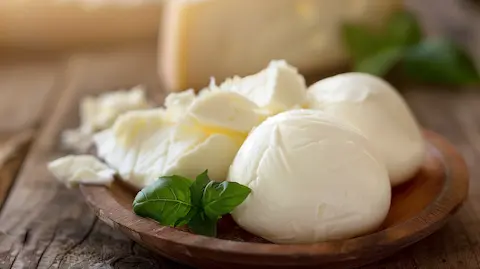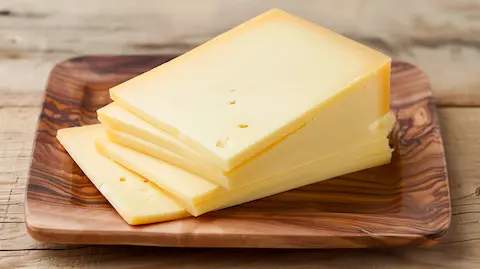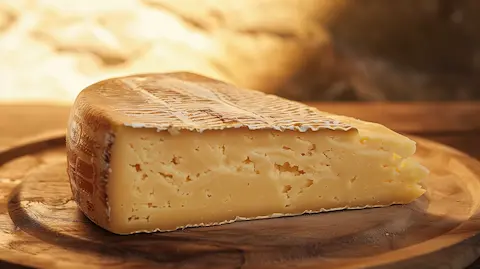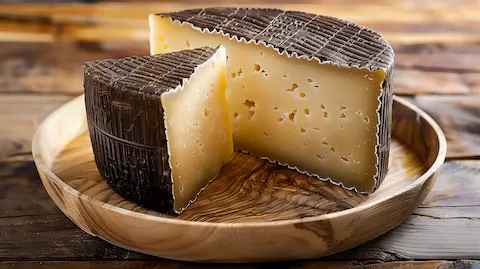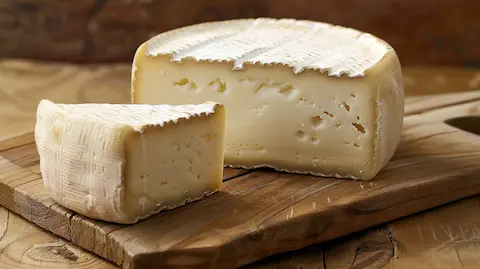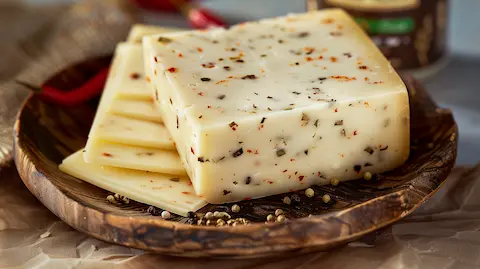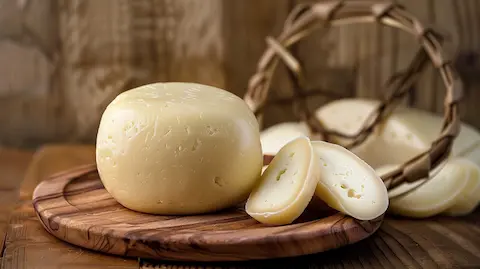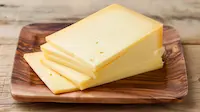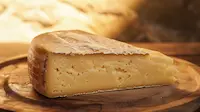Butterkase Cheese
Butterkäse is a semi-soft cheese celebrated for its creamy texture and buttery taste. Originating in Germany in the early 20th century, this cow's milk cheese quickly found favor for its mild flavor and versatility. With a pale yellow hue, Butterkäse presents a delightful alternative for those seeking a cheese that is rich yet not overpowering. Its smooth consistency makes it a favorite for melting over dishes or enjoying on a simple slice of bread. Despite its name, which translates to "butter cheese," Butterkäse contains no actual butter, yet it achieves a comparable richness and is often likened to a more nuanced Havarti or a young Gouda.
How is Butterkase Made?
Butterkase cheese is made using pasteurized cow's milk, which is gently heated before cultures and rennet are added to initiate the curdling process. The curd is then cut, allowing whey to separate and drain away. After this, the curds are pressed into molds and brined to infuse them with flavor and to start the aging process. Butterkase is typically aged for about one month, which contributes to its mild flavor and creamy texture. Throughout the production, careful attention is given to temperature and timing to ensure the cheese develops its characteristic buttery taste and semi-soft consistency.
Explore the Butterkase Production Process:
Butterkase Production Table
| Step | Ingredients | Method | Temperature | Duration |
|---|---|---|---|---|
| 1. Pasteurization | Cow's milk | Heat milk | 72°C (161°F) | 15 seconds |
| 2. Culturing | Milk, Starter cultures | Add cultures to milk | 30-32°C (86-89.6°F) | 30-60 minutes |
| 3. Coagulation | Milk, Rennet | Add rennet to set milk | 30-32°C (86-89.6°F) | 30-45 minutes |
| 4. Curd Treatment | Curd, Whey | Cut curd and drain whey | --- | --- |
| 5. Pressing | Curd | Press into molds | --- | 2-4 hours |
| 6. Brining | Cheese, Brine (salt water) | Submerge cheese in brine | --- | 12-24 hours |
| 7. Aging | Brined Cheese | Store at controlled temperature | 10-13°C (50-55.4°F) | 1 month |
What does Butterkase taste like?
Butterkase taste like a harmonious blend of creamy richness and gentle tanginess. Its flavor profile is mild with a hint of nuttiness, often compared to Muenster or Gouda, but with a unique buttery character that sets it apart. The texture is smooth and can be nearly spreadable, making it an exquisite choice for those who appreciate a cheese that complements without overpowering other flavors.
Butterkase Cheese Profile
Delve into the world of Butterkäse, and you'll find a cheese that's as versatile as it is delightful. Here's a snapshot of what makes Butterkäse stand out in the cheese realm:
- Made from: Pasteurized cow's milk
- Country of origin: Germany
- Region: Commonly produced in Germanic Europe and Wisconsin, USA
- Family: Semi-soft cheeses
- Type: Semi-soft, artisan
- Texture: Creamy and smooth, nearly spreadable
- Rind: Edible, thin, and golden
- Colour: Pale yellow to light yellow-orange
- Flavour: Mild, buttery, with a hint of nuttiness
- Aroma: Gentle, reminiscent of fresh milk
- Vegetarian: No, as traditional rennet is used
- Producers: Various, including specialty dairies in Germany and artisan cheesemakers in Wisconsin
- Safe for dogs: In moderation, as long as lactose intolerance or dairy sensitivity is not an issue
- PDO status: Not a Protected Designation of Origin (PDO) product
Origin: Where does Butterkase cheese come from?
Butterkäse, with its roots firmly planted in German soil, was first crafted in 1928. It was developed as a variant of the Italian bel paese cheese, which had been trademarked, prompting German cheesemakers to create their own version. The result was a cheese that not only rivaled its Italian counterpart but also surpassed it in popularity due to its rich flavor and adaptability. Today, Butterkäse is a cherished addition to the cheese boards of both its native Germany and the cheese-loving state of Wisconsin, USA.
How to Store Butterkase?
Storing Butterkäse properly is key to maintaining its delicate flavor and creamy texture. Keep Butterkäse refrigerated, ideally at temperatures between 1°C to 4°C (34°F to 39°F). Wrap the cheese in parchment paper followed by a layer of aluminum foil to protect it from air and moisture, which can lead to spoilage. If you notice any dryness or crusting, trim those parts away before consuming. For extended freshness, store Butterkäse in the least cool part of the refrigerator, such as a vegetable drawer, to avoid the drying effects of the coldest areas.
- Step 1: Wrap - Encase Butterkäse in parchment paper to allow it to breathe.
- Step 2: Cover - Add a layer of aluminum foil over the parchment for extra protection.
- Step 3: Place - Situate Butterkäse in the vegetable compartment of your fridge.
- Step 4: Check - Regularly inspect the cheese for any signs of spoilage and trim if necessary.
- Step 5: Consume - Enjoy Butterkäse within the optimal time frame for the best taste and texture.
How long does Butterkase cheese last?
Butterkäse cheese's lifespan varies depending on storage conditions. When kept in the fridge, it can remain fresh for up to two weeks. If you need to store it for a longer period, Butterkäse can be frozen, although this may slightly alter its texture and taste. When thawed, the cheese may become crumblier and less creamy, but it will still be suitable for cooked dishes where it can be melted. To enjoy Butterkäse at its best, consume it within the recommended time frames for each storage method.
| Storage Location | Shelf Life | Texture After Thawing | Taste After Thawing |
|---|---|---|---|
| Outside | 2-4 hours | ||
| Fridge | Up to 2 weeks | ||
| Freezer | Up to 2 months | Crumblier | Less creamy |
Is Butterkase cheese pasteurized?
Yes, Butterkäse cheese is made from pasteurized cow's milk. This process ensures the safety and consistency of the cheese, making it suitable for a wide range of consumers, including those who are pregnant or have compromised immune systems.
Can You Freeze Butterkase?
Yes, you can freeze Butterkäse. Freezing can be a practical option for extending the shelf life of this cheese beyond the typical fridge storage period. However, be mindful that freezing may change its texture, making it crumblier and less creamy. For best results, wrap Butterkäse tightly in plastic wrap or airtight freezer bags before placing it in the freezer. This method is particularly useful if you plan to use the cheese for cooking, where its altered texture will be less noticeable once melted.
How do you know if Butterkase cheese has gone bad?
To determine if Butterkäse has spoiled, look for signs of mold, an off smell, or a sour taste. Mold on cheese can present a health risk, especially if it is not a type intended to be mold-ripened. Eating moldy Butterkäse could lead to foodborne illness, so it's important to discard any cheese that shows signs of spoilage. If you're unsure, it's safer to err on the side of caution and not consume the cheese.
Alternatives to Butterkase Cheese
When Butterkäse is not available or if you're looking to experiment with different flavors and textures, there are several cheeses that can serve as suitable substitutes. These alternatives share characteristics with Butterkäse, such as a creamy texture or a mild flavor, making them excellent for similar culinary applications. Whether you're melting cheese over a dish or seeking a mild cheese for a cheeseboard, the following table provides a detailed guide to selecting an appropriate alternative.
Butterkäse Substitutes
| Cheese | Origin | Milk Source | Texture | Flavor | Aging Time | Best Used For |
|---|---|---|---|---|---|---|
| Havarti | Denmark | Cow | Creamy, semi-soft | Mild, buttery | 3 months | Sandwiches, melting |
| Gouda (young) | Netherlands | Cow | Semi-soft to firm | Sweet, nutty, mild | 1-6 months | Snacking, sandwiches |
| Muenster | France/USA | Cow | Soft, smooth | Mild, slightly tangy | 5-7 weeks | Grilled cheese, burgers |
| Bel Paese | Italy | Cow | Semi-soft | Buttery, milky | 6-8 weeks | Snacking, melting |
| Tilsit | Germany | Cow | Semi-hard | Strong, pungent | 2-3 months | Cheese platters, sandwiches |
| Fontina | Italy | Cow | Semi-soft | Rich, nutty | 3 months | Fondue, pizza |
Butterkase Popular Comparison
Butterkäse is frequently compared to Havarti, a Danish cheese known for its creamy texture and mild, buttery flavor. Both cheeses are excellent for melting and share a similar versatility in the kitchen, making them interchangeable in many recipes.
Butterkäse vs. Havarti
| Cheese | Origin | Milk Source | Texture | Flavor | Aging Time | Uses |
|---|---|---|---|---|---|---|
| Butterkäse | Germany | Cow | Creamy, semi-soft | Mild, buttery | 1 month | Sandwiches, melting |
| Havarti | Denmark | Cow | Creamy, semi-soft | Mild, buttery | 3 months | Sandwiches, melting |
How to Use Butterkase
Butterkäse's creamy texture and mild flavor profile make it an excellent choice for a variety of culinary applications. Its ability to melt smoothly lends itself well to comforting dishes like grilled cheese sandwiches, macaroni and cheese, or a decadent topping for burgers. Sliced, it adds a creamy layer to cold sandwiches or can be enjoyed simply on crackers. If you're looking to add a subtle richness to your cooking without overwhelming other ingredients, Butterkäse is an ideal inclusion.
- Slicing for sandwiches and cold cuts
- Melting in grilled cheese, omelets, or on top of burgers
- Shredding for casseroles, pastas, and pizza
- Dicing for salads or cheese trays
- Pairing with fruits and nuts for a balanced cheeseboard
Popular Uses for This Cheese
| Use | Description |
|---|---|
| Melting | Perfect for dishes that require a smooth, creamy cheese that melts evenly. |
| Sandwiches | Enhances sandwiches with its mild flavor without overpowering other ingredients. |
| Cooking | Integrates well into recipes, adding a rich, buttery note to cooked dishes. |
| Snacking | Ideal for a quick, satisfying snack on crackers or with fruit. |
| Cheeseboards | Complements other cheeses and accompaniments on a cheese platter. |
How to Serve Butterkase Cheese
Serving Butterkäse cheese is all about highlighting its creamy texture and mild, buttery flavor. For a simple yet satisfying experience, serve it at room temperature to allow the full range of flavors to emerge. It pairs exceptionally well with light-bodied wines and lagers that complement its delicate taste. On a cheeseboard, accompany Butterkäse with fruits like grapes or slices of pear to enhance its natural sweetness. For a more savory approach, pickles or mustards can provide a delightful contrast.
Recipes Using Butterkase
Butterkäse's mild flavor and meltability make it a star ingredient in various recipes. Its creamy nature enhances comfort foods while not overpowering other ingredients. This cheese's versatility allows it to blend seamlessly into dishes, providing a subtle richness that can elevate the simplest of meals.
- Grilled Cheese Sandwich: Butterkäse melts beautifully, creating a gooey and irresistible center in this classic comfort food.
- Macaroni and Cheese: The cheese's smooth texture and mild taste make it a perfect addition to this beloved dish, offering a creamy consistency without dominating the flavor profile.
- Cheese Omelette: Adds a creamy, buttery touch to a breakfast favorite without overwhelming the eggs and fillings.
- Burger Topping: A slice of Butterkäse on a burger melts into a rich, velvety layer that complements the savory meat.
- Spaetzle: When mixed into this German noodle dish, Butterkäse contributes a delightful creaminess that binds the ingredients together.
- Strudel Filling: Offers a mild, buttery contrast to the flaky pastry, especially when paired with savory fillings like spinach or mushrooms.
Butterkase Nutrition Data
There are 334 calories in butterkase cheese per 100g. This cheese also provides a significant amount of protein and fat, making it a substantial addition to your diet. With its rich butterfat content, Butterkäse is a source of energy and can be a delicious part of a balanced diet when consumed in moderation. Additionally, Butterkäse contains calcium, which is important for bone health. However, due to its fat content, it should be enjoyed in sensible portions, especially for those monitoring their calorie intake.
| Nutrient | Amount per 100g | % Daily Value* |
|---|---|---|
| Calories | 334 | --- |
| Total Fat | 26g | 40% |
| Saturated Fat | 18g | 90% |
| Cholesterol | 100mg | 33% |
| Sodium | 500mg | 21% |
| Total Carbohydrates | 1g | <1% |
| Dietary Fiber | 0g | 0% |
| Sugars | 0g | --- |
| Protein | 25g | 50% |
| Calcium | 700mg | 70% |
| Iron | 0mg | 0% |
*Percent Daily Values are based on a 2,000 calorie diet. Your daily values may be higher or lower depending on your calorie needs.
What's Next? WhatCheese Insights
If you are a connoisseur of fine cheeses or simply a curious foodie looking to expand your palate, Butterkäse is a must-try. While it may not be as widely recognized as some other cheeses, its approachable flavor profile makes it an excellent candidate for both cheese novices and seasoned aficionados. For those interested in purchasing Butterkäse, specialty cheese shops and well-stocked supermarkets often carry this semi-soft delight. Moreover, if you are in Germany or Wisconsin, local dairies may provide the freshest options. Renowned vineyards in these regions also offer cheese tastings, where Butterkäse can often be found paired with wines that accentuate its creamy, buttery notes.
Butterkäse is not only a treat for the taste buds but also a versatile ingredient in the kitchen. Its melting qualities make it a top pick for culinary events and cooking classes focused on European cuisine. Keep an eye out for local food festivals or cheese-centric events that feature Butterkäse, as these can be wonderful opportunities to learn more about this cheese and how to incorporate it into various dishes. Additionally, for those who enjoy the art of pairing, Butterkäse's mild flavor harmonizes beautifully with a range of beverages, from crisp white wines to light lagers, offering a delightful tasting experience.
For those who savor the creamy, semi-soft textures of cheese, there are several other varieties that might pique your interest. Gouda, particularly the young kind, offers a similar mildness with a hint of sweetness. Muenster, with its smooth texture and subtle tang, can also be a delightful alternative. If you're seeking something with a bit more character, Havarti's buttery notes and slightly firmer texture could be just what you're looking for. Each of these cheeses presents a unique profile that can enrich your culinary adventures and cheese-tasting experiences.


